
MAY CONTAIN NUTS

Search Shorpy
SHORPY ART

Framed or unframed, desk size to sofa size, printed by us in Arizona and Alabama since 2007. Explore now.
Join and Share
Ad-Free Shorpy
Shorpy is funded by you. Patreon contributors get an ad-free experience.
Learn more.

Recent comments
- Lost in Toyland
- And without gloves
- If I were a blindfolded time traveler
- Smoke Consumer Also Cooks
- Oh that stove!
- Possibly still there?
- What?!?
- $100 Reward
- Freeze Frame
- Texas Flyer wanted
- Just a Year Too Soon
- WWII -- Replacing men with women at the railroad crossing.
- Yes, Icing
- You kids drive me nuts!
- NOT An Easy Job
- I wonder
- Just add window boxes
- Icing Platform?
- Indiana Harbor Belt abides
- Freezing haze
- Corrections (for those who care)
- C&NW at Nelson
- Fallen Flags
- A dangerous job made worse
- Water Stop
- Passenger trains have right of way over freights?
- Coal
- Never ceases to amaze me.
- Still chuggin' (in model form)
- Great shot
Member Photos
The Shorpy
Print Emporium
Print Emporium
Search Shorpy
Search results -- 30 results per page
- Jazz Feeds: 1936
- ... feed store, March 1936. View full size. Photograph by Walker Evans.
Bad pun I bet you could buy feed here for your Archie Sheeps. ... Posted by Dave - 08/20/2012 - 1:13am -
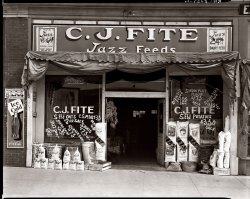
- Mount Pleasant: 1935
- ... Westmoreland County." View full size. Photograph by Walker Evans, Farm Security Administration.
Life looked so much more Life ... Posted by Dave - 08/03/2012 - 11:36am -
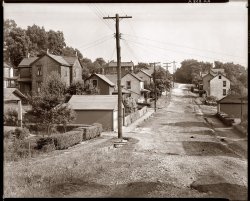
- Neighbors: 1936
- ... Virginia." Large-format nitrate negative by Walker Evans for the Farm Security Administration. View full size.
Along the ... TK
tk42one@gmail.com
(The Gallery, Small Towns, Walker Evans) ... Posted by Dave - 04/30/2009 - 4:00pm -
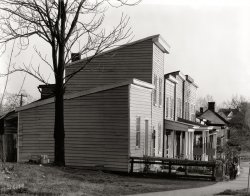
- Fancy Grocery: 1935
- ... December 1935. "Coca-Cola shack in Alabama." Photograph by Walker Evans. Back in the 1930s just about any building or barn was like a Web site ... Posted by Dave - 08/20/2012 - 1:09am -
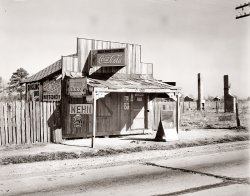
- Catfish Mover Watermelon: 1936
- ... Alabama. View full size. Medium-format negative by Walker Evans for the Farm Security Administration.
Phone Numbers My family in ... Posted by Dave - 08/08/2012 - 12:31pm -
![Catfish Mover Watermelon: 1936 Summer 1936. Roadside stand near Birmingham, Alabama. View full size. Medium-format negative by Walker Evans for the Farm Security Administration.
Phone NumbersMy family in central Nebraska used 5 digit direct dialing until the late 1990s. What happened? The internet - they now have to dial 10 numbers whether it's local or long distance. On the plus side, they have one of the last private phone companies, and even though my parents live 7 miles out in the country, they could have dsl if they wanted it, because their phone company ran fiber optic lines to [i]all[/] of their customers.
I'm half a mile from a Verizon "office" (it's actually more of a switching station), and I can't get DSL. Yeah, I know that legally they should be providing it, but "who ya gonna call?" It's a huge corporation - "your call is very important to us..., but we are experiencing high call volume..."
No redial eitherI recall back then we had rotary phones, no contact list and not even redial. Every extra number could become a real pain to the index finger. Of course, that's if the line was free and there wasn't another party on the line. I still remember when I was caught listening to the telephone when I was very young. I had no idea why my mother would get so upset. In my neighborhood a private line was very rare.
Phone numbersAs late as 1979, in Sonoma, California, if you were calling in town you only needed to call the last four numbers, everyone had the same prefix.
Five-digit phone numbersI don't know how things worked in Birmingham, or in Bar Harbor, but in my home town in Indiana, the way it worked was, we had seven-digit phone numbers, but if the number you were calling was in the same exchange as yours, you only dialed the last five digits.
So if your phone number was KLaxon 5-3270 (555-3270), and someone was calling you from another KLaxon phone number, they would dial 53270. If someone was calling you from the CHerry exchange, they would dial 5553270. Exchanges were kind of like area codes, only for smaller areas. (Area codes went into effect in 1947. I just looked that up.)
By the time I came along, pretty much every business would display the full seven-digit number, as either the exchange name and five numerals, e.g., KLaxon 5-3270, or two letters and five numerals, e.g., KL5-3270. I don't remember ever seeing just the last five numerals.
I remember when the switch was made in the mid-60s (where I lived, at least) to seven-digit dialing for all phone numbers, but I was too young to know if people found it to be a big wrench to the system. Some businesses still referred to their phone number as "TUxedo 4 -xxxx" or "YEllowstone 8 - xxxx" or whatever well into the 70s.
[In 1947 the North American Numbering Plan laid the groundwork for direct dialing of long distance calls. The first area codes came into use in 1951, but it would be many years before direct dialing and area codes really took hold. - Dave]
3-9596Is that the entire phone number on the top of the sign? I'm guessing that there were not many phones in use back then and therefore we had not reached the need for 10 digit numbers. Amazing.
Justin
Houston, TX
[Below: Example of a three-digit phone number from the 1950s - Dave]
Hello CentralWhen the numbers were that short, they probably went through an operator. Our telephone number was 200 but you told the operator you wanted Commerce (the town) 200. We didn't have dial telephones back then (even rotary).
Olive OylWhen I was a kid in the early 1940s we used to call up a store and ask if they had olive oil in a can, and when they said yes we would say better let her out, Popeye is looking for her, and then we would laugh like crazy.
(The Gallery, Birmingham, Stores & Markets, Walker Evans)](https://www.shorpy.com/files/images/8c52874u.thumbnail.jpg)
- Bethlehem Boys: 1935
- ... Pennsylvania. View full size. 35mm nitrate negative by Walker Evans for the FSA.
In a few years Most of them look like they'd be old ... Posted by Dave - 02/10/2009 - 12:38pm -
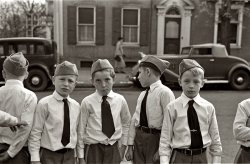
- New Orleans: 1935
- ... street," December 1935. View full size. Photograph by Walker Evans. X's at bottom are crop marks.
Looks like the St. Louis Looks like ... Posted by Dave - 09/07/2011 - 6:09pm -
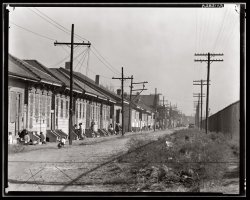
- Barbershop Duet: 1936
- ... barber shop, Atlanta." Large-format nitrate negative by Walker Evans for the Resettlement Administration. View full size.
Gone to the ... Posted by Dave - 08/24/2011 - 8:41am -
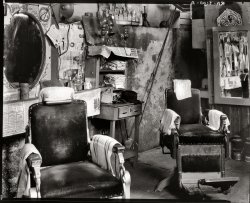
- Room and Bird: 1936
- ... on Saint Charles Avenue." Large-format nitrate negative by Walker Evans for the Farm Security Administration. View full size.
$2 I ... Posted by Dave - 07/19/2012 - 4:31pm -
![Room and Bird: 1936 January 1936. "New Orleans architecture. Cast-iron grillwork house near Lee Circle on Saint Charles Avenue." Large-format nitrate negative by Walker Evans for the Farm Security Administration. View full size.
$2I forgot to make reservations this year for the Mardi Gras parades, do you think I can still get the advertised rate?
TweetDid anyone else search every square inch of the grillwork looking for the bird?
[Hello? They're right in front of your nose. - Dave]
Re: TweetI, too, searched for the elusive bird, never thinking to look IN the window. Guess my super-sleuthing abilities are somewhat less than super.
Conservative Chimney...It leans to the right.
And it's singing . . "I'm only a bird in a gilded cage"
Bebop on down to BirdlandNew Orleans. Jazz. SAINT CHARLES. Who needs a gilded cage?
Am I Psyhic or PsychoThis image looks to me to be a repeat. The frontal scene and especially the ornate grillwork struck a memory chord. However, I searched Shorpy using various combinations of caption words or phrases (cast-iron, grillwork, ornate, etc.) to no avail.
Is this the same of smilar to a posted picture in, say, the past 6 months? (Should I mention that I have been having vivid and interesting dreams of late?)
[Did you search for "Orleans"? - Dave]
Chez IgnatiusSweet mercy.
When I see pictures of the glorious past of New Orleans, my first thought is: How in the living hell did they stand the heat in the summer?
Yes, I know. As my mother whose clan is from New Orleans says, they were much tougher folks in those bygone days.
I just bet they were. But I guarantee I smell better than any of them after a long, sticky, hot summer night spent in my air conditioned home rather than sprawled out on the front porch because it was too damn hot to sleep inside.
Motel 2The $2 room is the one overhanging the alleyway with floor about to give way and wrapped in high-voltage wiring!
Lake PontchartrainIn a gentler time, during the New Orleans summer, thousands of people would sleep out on the south shore of Lake Pontchartrain.
(The Gallery, New Orleans, Walker Evans)](https://www.shorpy.com/files/images/8c52099u.thumbnail.jpg)
- Star Pressing Club: 1936
- ... Laundry and barber shop." Large-format nitrate negative by Walker Evans. View full size.
Meter Readers Did the electrical meter ... Posted by Dave - 09/12/2011 - 4:53pm -
![Star Pressing Club: 1936 February 1936. Vicksburg, Mississippi. "Negro shop fronts. Laundry and barber shop." Large-format nitrate negative by Walker Evans. View full size.
Meter ReadersDid the electrical meter readers work on stilts?
A little off the topDave, can we see a close-up of the hairstyle chart above the barbershop door?
Zipper effectThe siding on the building shows the "zipper effect", where the joints in the boards follow a repeated pattern, usually due to the length of the boards as they were made at the mill, versus the width of the building. It's an effect you're supposed to work to avoid, by cutting boards at different lengths, to avoid creating a pattern.
Bigfoot?The person who read the electric meters in Vicksburg must have been extraordinarily tall.
Pressed HairI'm going to guess that the "Star Pressing Club" is for the purpose of pressing hair.
[It's a laundry. See the clothes? - Dave]
Pressing ClubIt's the name of a dry cleaner, some still operating in the South.
Thought BalloonThe siding looks typical of the cartoons of the 1930's. Popeye for example. Also very Robert Crumby. Especially where the siding joins in the upper left. The horizontal splits in the siding at the joins and the nailheads are also typical of the comics of the period.
2D Barber PoleI love the way the barber pole has been painted in the space between the doors.
L. PalmerThis is Joe Manning. In the 1930 census, there was one African-American person named Palmer listed in Vicksburg whose first name begins with L. He was Luther Palmer, born in 1890, his occupation given as a tailor running a tailor shop. I had a strong feeling he was the L. Palmer on the sign. Then I found a Luther Palmer, born in 1899, who died in Mississippi in 1963, and then found his son, a retired professor at Texas A&M University. I called him, and after a very interesting conversation which seemed to establish a good possibility that his father was the man who owned the 1936 business, I realized I had forgotten to mention that it was a "Negro" business. At that point, Professor Palmer told me he was white. Case closed? Probably, but is there a small chance that the business was owned by his white father, but run by African-Americans? He didn't think so. After 1930, there are no records for any other Luther Palmers who appear to be the one I found in the 1930 Census.
Wrong PlaceSomeone's chalked "Wrong Place" to the left of the barbershop window.
120 Volt Electric serviceHaving been in the electrical distribution business for the past 40 years it is interesting (to me, anyway) to see the old style 120 volt meter service on both sides of this building. Each serving the business on either side. There were still, believe it or not, two wire 120 volt, 30 amp services still in existence up until just a few years ago!
(The Gallery, Stores & Markets, Vicksburg, Walker Evans)](https://www.shorpy.com/files/images/8c52127u.thumbnail.jpg)
- Will Work for Food: 1935
- "Mule in Hale County, Alabama, 1935." Photo by Walker Evans. View full size.
Named Francis ended up in Hollywood making ... Posted by Dave - 05/16/2009 - 6:42pm -
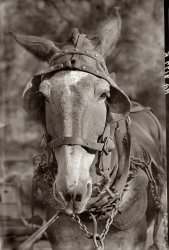
- Bethlehem: 1935
- ... Bethlehem, Pennsylvania." Large-format nitrate negative by Walker Evans for the Farm Security Administration. View full size.
Washday ... Posted by Dave - 02/10/2009 - 12:39pm -
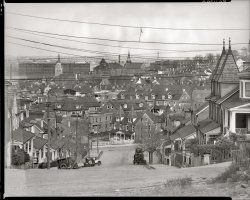
- The Neighbors: 1936
- ... of the town. Birmingham, Alabama." Nitrate negative by Walker Evans for the Resettlement Administration. View full size.
Nice Lines ... Posted by Dave - 09/05/2012 - 6:05pm -
![The Neighbors: 1936 March 1936. "Middle class houses of the town. Birmingham, Alabama." Nitrate negative by Walker Evans for the Resettlement Administration. View full size.
Nice LinesThe contrasting images and diagonal lines criscrossing this scene are astounding.
Masonry DetailsI love this photo. Not having ever been to Birmingham (I imagined Birmingham as being flat) nor being schooled in the journeyman practice of masonry, several details stand out:
The thinness of the brick piers holding up the bungalows on the hillside
The masonry arch caps on the chimneys
The stonework terracing within the cemetery hillside
The fieldstone cemetery wall
All together, it appears to highlight a profound contrast to the present day: an attention to detail combined with relatively inexpensive labor and maximum use of local stones.
FavelaI was also struck by those piers ... just waiting for a good wind gust. Also, the scene reminds me of a South American hillside barrio or favela, with no real streets in sight. Presumably the substantial houses at the top of the hill are facing a real street, but everything else is served only by footpaths.
StiltsI'm amazed at the houses on the brick pillars. It looks like one small earthquake could take them out.
QuietAh - nice quiet neighbours. Bliss.
Birmingham PlotsI grew up in Birmingham. Neighborhoods like this have been a victim of urban blight and many small frame homes like these have been torn down.
Construction like this was common throughout Alabama, Mississippi and Louisiana -- cheap and allows maximum circulation for the summer months. My last home in Jackson, Mississippi, dates from 1915 and the foundation is exactly the same as these houses, albeit on not as steep of a grade.
Fieldstone walls and houses are very common in the Birmingham area, as are terraced cemeteries. I wish I could identify this one, sadly the only last name visible is a very common one. If anyone is able to figure out where this is I'll ask my father to take a photo. It looks like a white cemetery in the foreground and the unlandscaped plot behind it is more than likely a black graveyard. Burial grounds were segregated until the late 1960's there.
Bone OrchardNice solution to the slope in the cemetery. I guess that kept Granny from scrunching down in the toe-end of her box.
Moline, ILThis picture reminds me of my grandma's house in Moline IL! Her basement was built into the side of a hill with two floors above. The house was torn down in the late 80's. Looking at the lot today, no one would suspect that a house ever sat there. Thanks for the memory Shorpy!
Vigilando...Los porches de las casas miran, vigilantes, hacia el cementerio.
Entre éste y las casas se está realizando una ampliación en la que algunos, previsores, han empezado a construir su tumba, aún más cerca de las casas.
...gracias, SHORPY.
Hilly BirminghamI live in Birmingham. Like much of northern Alabama, it's quite hilly. The city sits in a valley between Red Mountain and Shades Mountain. There are lots of old neighborhoods built on the slopes of one hill or another. This neighborhood could have been on the North Side of downtown, judging by the houses and the cemetery on the slope. Some of our city's most interesting homes sit precariously on the side of Red Mountain.
Press uno por EnglishUppa you ess!
[Dear Norm: Anyone is welcome to submit a comment here regardless of the language they speak. Civility and good manners are a requirement, however. - Dave]
Es VerdadI thought Paco's comment was beautiful, either in Spanish or in English translation. Anyone can easily obtain Spanish to English translation on the Internet.
Somewhere in BirminghamI live in Birmingham and I believe that this picture was taken by the airport.
I'm Guessing Pratt CityI'm thinking this could have been around Irish Hill (now Dugan Avenue) in the Pratt City section of Birmingham.
Birmingham PhotoI grew up in Birmingham and my father who also grew up there loved to take my brother and I to all sorts of ineresting places that most people didn't know about. The picture is of the original Jewish cemetary which is somewhere around Birmingham Southern College and the current interchange of I-65 and I 59/20. I was too young to remember exactily the location but since I had never seen anything like the cemetary I never forgot it.
Birmingham cemeteryI took locating this photograph as a challenge, and I believe I have it placed.
I was a child long ago in Birmingham also, although I never saw this particular cemetery.
I think the photograph was taken in Knesses Israel Cemetery at about the center of the cemetery, Latitude: 33.522351 and Longitude: -86.831288 with the camera pointing to the northeast. This is consistent with the post George Adams made.
The key to identifying it was the church at the top of the hill on the left side of the photograph with the patched tin roof and the twin towers. I believe that to be Old Sardis Baptist Church located at 1240 4th St N., now with the top of the southern tower removed, the roof's peak lowered, and its exterior walls veneered with red brick. From what I can see with Google Satellite and Streetview, it's the only recognizable structure in the picture still remaining, and most of the lots where houses are shown then now have trees or underbrush covering them.
Baker grave in pictureGoing from Norwood_nomad's comment, I found the coordinates for Baker grave in the photo on Find a Grave here 33.5225503,-86.8315599.
(The Gallery, Birmingham, Walker Evans)](https://www.shorpy.com/files/images/8c52172u.thumbnail.jpg)
- Scotts Run: 1935
- ... Virginia. July 1935. View full size. Photograph by Walker Evans.
(The Gallery, Great Depression, Walker Evans) ... Posted by Dave - 08/08/2012 - 8:17pm -
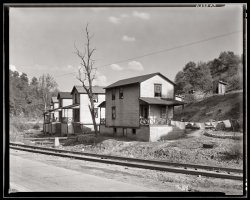
- The Black Cat: 1936
- ... of a sharecropper's cabin, Hale County, Alabama." Photo by Walker Evans for the Farm Security Administration. View full size.
Nutrition ... Posted by Dave - 10/31/2016 - 9:49am -
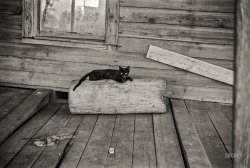
- Sweet Home Alabama: 1935
- ... scene in Selma, Alabama." Large-format nitrate negative by Walker Evans for the Resettlement Administration. View full size.
Cook ... Posted by Dave - 03/22/2009 - 10:53pm -
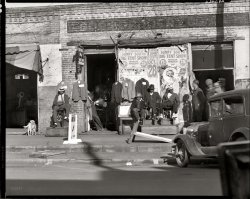
- Vicksburg: 1936
- ... Vicksburg, Mississippi." 8x10 inch nitrate negative by Walker Evans for the Resettlement Administration. View full size.
Social ... other for at least 75 years?
(The Gallery, Vicksburg, Walker Evans) ... Posted by Dave - 01/27/2021 - 1:36pm -

- Sharecropped: 1936
- ... Hale County, Alabama." 35mm nitrate negative by Walker Evans for the Farm Security Administration. View full size.
New shoes ... Posted by Dave - 10/23/2014 - 5:06pm -
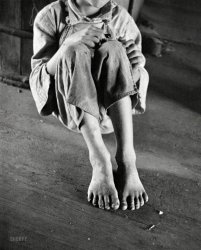
- A Face in the Crowd: 1936
- ... portraits. Birmingham, Alabama." 8x10 acetate negative by Walker Evans for the Resettlement Administration. View full size.
Let's ... Posted by Dave - 02/09/2021 - 2:05pm -
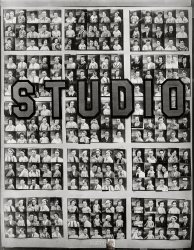
- Liberty Theatre: 1935
- ... with a product tie-in. Large-format nitrate negative by Walker Evans, Resettlement Administration. View full size.
Six adult tickets ... Posted by Dave - 09/12/2011 - 4:58pm -
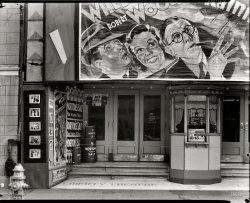
- Of the Community: 1936
- ... Plantation, Louisiana, 1858. Closeup of column." Photo by Walker Evans for the Resettlement Administration. View full size.
All In All ... Posted by Dave - 02/18/2016 - 12:32pm -
![Of the Community: 1936 Circa 1936. "Belle Grove Plantation, Louisiana, 1858. Closeup of column." Photo by Walker Evans for the Resettlement Administration. View full size.
All In AllAnother great Shorpy title; well done, Dave.
Celebrated houseBelle Grove was magnificent and probably the grandest of the antebellum plantation homes. It appeared in the landmark, two-volume book "Lost America" in 1971. There's another book from 1945 which was a photo gallery of both ruined and standing plantation houses, and it included several pages of close-up photos of Belle Grove made while it was in a state of decay but still standing. I believe this was titled "Ghosts Along the Mississippi," but I don't have it in front of me right now to provide the photographer/author's name.
By that time the house had been vacant for at least 20 years, and parts of it had already fallen. What remained was removed during the 1950s following extensive flood damage.
Perhaps, Shorpy will treat us to a few more views, including an overall shot of this grand old lady of yesteryear. Pretty please?
[Enter "Belle Grove" in the Search Shorpy box and you'll see three more. -tterrace]
IconicIonic column.
[It's Corinthian, however. -tterrace]
How do you know since the capital is not visible?
[Because this. -tterrace]
(The Gallery, Walker Evans)](https://www.shorpy.com/files/images/SHORPY-8b26932a.thumbnail.jpg)
- American Gas: 1935
- ... Reedsville, West Virginia." 8x10 inch nitrate negative by Walker Evans for the Resettlement Administration. View full size.
My two ... Posted by Dave - 09/02/2019 - 6:17pm -
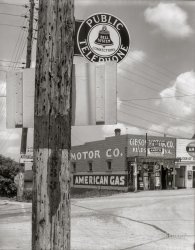
- Paging Edward Hopper: 1940
- ... by documented, well-known, and legendary photographers. Walker Evans. Lewis Hine. Dorothea Lange. Ben Shahn. Russell Lee. Look them up.
... Posted by Dave - 09/07/2011 - 2:43pm -
![Paging Edward Hopper: 1940 Children in the tenement district, Brockton, Massachusetts. December 1940. Photograph by Jack Delano. View full size. These duplexes must have been fairly grand when they were new, probably around the turn of the century. They look like the house where Granny and Tweety Bird lived. Are they still there?
I'll get it running some dayEver since there have been cars somebody has put them on blocks and abandoned them.
Are you sure that picture isn't a model?Look at the people. They just don't look real. And neither does the car or the big tree limb in front of it all.
They are still there...I can't promise you that these exact ones are still around, but there are many that look just like this in Brockton. Some have been restored, some are still run down.
Sure it isn't a model?The people don't look real. The car looks like a toy, and the tree limb in front of it all is huge.
Tree limb??That's a telephone pole. Click here. Another version is here.
Telephone pole?Actually it is a power pole, there are no telephone lines on it. If you look real close you can see the telephone pole and lines in the back.
ever wonder?Ever wonder what the people's thoughts were at the moment the photo was taken? A. Moore
Re: Sure it isn't a model?I haven't poked around this site a lot, so maybe this info is here somewhere (yeah, yeah, I read the explanation of the Shorpy name) -- but maybe you should explain more background to a lot of these photos from the 30s and 40s.
Of course they're real.
These are by documented, well-known, and legendary photographers. Walker Evans. Lewis Hine. Dorothea Lange. Ben Shahn. Russell Lee. Look them up.
The photos are so detailed because they used large format cameras with honking big negatives.
http://xroads.virginia.edu/~UG97/fsa/welcome.html
Read the book Let Us Now Praise Famous Men. Get a hardcover copy that really shows off Walker Evan's photos.
And keep looking back here for more leads on great documentary photography.
Looks real to me.I'm loving those roofs. The shape is wonderful.
How pretty these homes must have looked when new.
This, and "American Gothic".I don't know if it's of any use, but if you look at the "American Gothic" image (another from this shoot), the number 22 is chalked onto the left door on the porch. Maybe somebody who knows Brockton (Dianne Cantara, where are you?) can track down this locale and tell us what's there now.
FantasticThese houses are fantastic.
Are they duplexes or quads? That's an amazing amount of house for a duplex!
Mansard RoofThere are many examples of this style of house where I live, I grew up in one very similar that had 4 single family homes in it, each of which is now at least 5 apartments. The roof style is a Mansard roof if I'm not mistaken and is fairly common in the Northeastern US and Canada, it stands up well to a heavy snowload.
Mansard RoofThe mansard roofs and style of these houses is called the French Second Empire style. In the last half of the 19th century, it was common to have roofs with dormers. It provided an extra residential floor, but tax assessments did not count the top floor in the market appraisals, so owners were, in effect, adding a floor to the building without being taxed for it. This was explained to me by a historian who recently gave a wonderful two-hour walking tour of houses and mills along the Quinebaug River in Putnam, Connecticut. You can see some interesting information about this at:
http://www.americanlandmarks.com/french.htm
They are there!I grew up in Brockton and those places are still there!
Brockton, Mass.Would anyone please post the address of the location this shot was taken? I am working on a photogray project where I am shooting with a similar vision as Edward Hopper paintings. These Mansard Roof homes would be perfect subject matter at sunrise/sunset.
Oh, please forward the address to my e-mail at sternedwards@aol.com
Thanks In Advance,
Charles Roland
1932 Ford Standard TudorThe car is a 1932 Ford Standard Tudor and the color is Washington Blue. I have one just like it.
Look at the detailsI see details such as the fading wreaths in the windows, the rain downspouts that have a "Y" connectors from the second floor roof to the bay window roofs, then to the next level and then down to the ground; the corbels in the entry way. So many homes had them as trim items and so many are removed today. A lot of architectural character is missing in today's homes.
Is it totally genuine?The power pole looks fake at the base, and its shadow is narrower than the pole itself. And take a look at the shadow of the child in black: different angle. The dog ... oh well ... no shadow at all. Maybe not totally fake, but surely retouched.
[The shadow of the pole would be the same width as its base if you could see where two the came together behind the where the dirt has built up along the pavement. The shadow on the ground next to the kid is cast by whatever he's holding; his own shadow is much smaller, like the dog's. - Dave]
(The Gallery, Brockton, Cars, Trucks, Buses, Dogs, Jack Delano, Kids)](https://www.shorpy.com/files/images/1a33854u_0.thumbnail.jpg)
- Whitewash: 1935
- ... Alabama." View full size. 8x10 nitrate negative by Walker Evans for the Farm Security Administration.
Actually... ...that looks ... Posted by Dave - 09/08/2011 - 9:45pm -
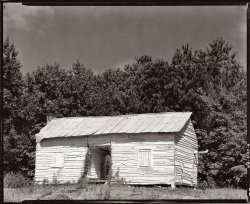
- Country Church: 1936
- ... probably Alabama or Tennessee." 8x10 safety negative by Walker Evans for the Farm Security Administration. View full size.
Unusual ... Posted by Dave - 05/02/2008 - 3:57pm -
![Country Church: 1936 1936. "Church, Southeastern U.S., probably Alabama or Tennessee." 8x10 safety negative by Walker Evans for the Farm Security Administration. View full size.
Unusual DesignI don't know that I've ever seen a church quite this style in the South -- the wood looks added on to a secular building of some kind. The three crosses are interesting, and the one in the center is crooked--and is that a bird perched on it? There's also no signage over the doors, which is odd. Fascinating building, clearly cobbled together.
[Look again. There is a sign. Plus a cornerstone. - Dave]
Southern CrossWhat is that thing on the middle cross. It doesn't look like a bird. Dave, can you use your super enhancing powers? Go go gadget magnifier?
[Ta-da. - Dave]
What a Letdown...It's a bit of wood.
Thanks anyway!
Super-Enhancing Go-Go GadgetCould you also employ your ultra-flux-capacitor, U236, turbo-rastermatic, Fireball, perma-firm, sofa-wide powers to explain . . .
Okay, so it aint funny and I caint spell aint.
Still, your scans are the best and your site(s) are my favorite(s) on the web. Keep up the good work.
Foy Blackmon
Las Vegas
That Cross add-onMy first impression is that the small upright remembers the Thief on the Right at the crucifixion. Remember? The thief on the left scoffed at Jesus and blamed others for all that had happened to him,almost demanding that Jesus save him on his own terms.
The thief on the right admitted his guilt and simply asked Jesus to remember him.
The Orthodox Church’s cross has an additional shorter piece above the main crosspiece,and at the bottom is a smaller slanted piece. The upper piece represents the sign placed above Jesus’ head (on the Orthodox cross). And the lower piece slants toward the right as a reminder of the thief on the right.
Mike
This Site Teaches me So Much!Thank you Mike. I love the collaborative effect this site has in broadening my knowledge.
And thank you Dave, for my absolute favourite site!
Re: that Cross add-onA follow-up:
My friend Dr. John Sasser (http://www2.eos.net/jsasser/) noted this in reference to the cornerstone, and church name:
"The African Methodist Episcopal Church, with the "cross +" between the M and E, i.e., M+E has a very exciting history that is embedded in African tradition, i.e., voodoo, folk-lore or whatever you wish to call it...."
(this cross example may) "...fit with some African-based religious practices that have been labeled voodoo are (in fact) biblical."
[Or it could be a bit of bracing on the back of the cross that's come loose. - Dave]
(The Gallery, Rural America, Walker Evans)](https://www.shorpy.com/files/images/8c52444u.thumbnail.jpg)
- Ensley Furnace: 1936
- ... skeleton of a snagged kite. 8x10 inch nitrate negative by Walker Evans for the U.S. Resettlement Administration. View full size.
Long ... Posted by Dave - 01/04/2023 - 12:46pm -
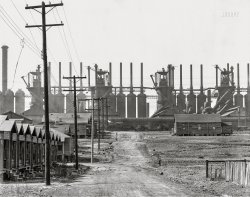
- Meet Crushy: 1936
- ... "Waterfront warehouses." Large-format nitrate negative by Walker Evans for the Farm Security Administration. View full size.
Peters ... Posted by Dave - 11/05/2012 - 11:10pm -
![Meet Crushy: 1936 March 1936. Savannah, Georgia. "Waterfront warehouses." Large-format nitrate negative by Walker Evans for the Farm Security Administration. View full size.
Peters Bottling CoAll I could find: 1950, Savannah City Directory, 116-118 West Bay Street. Older buildings are there, but not the ones pictured.
Afternoon Sugar TimeWhen I was eight years old in the mid 1950's, I attended a two week long summer camp in the Irish Hills of Michigan. The camp did not have a camp store or PX. However, after the mandatory post lunch rest period each day, the cabin counselors would give you a red plastic bingo card chip and a metal washer. These would be traded in at the camp activity hall for an ice cold Orange Crush and a candy bar. Still love orange pop and chocolate to this day. I try to limit it to once a month. Later when I joined the Boy Scouts, the summer camps had PXs. A cherry Coke with a bag of salted peanuts poured in the cup was popular back then.
Parsed Exceeding FineSo, presumably Golden Spike is the analog of Canada Dry, while Buffalo Rock is a Vernor's sort of drink? And to meet this Crushy (if that really _is_ his name), one slips in through the loading dock and makes for the employees' break room? I dialed 4332 for the answer to those and other queries, but apparently nobody's home.
Crushy's familyAs you may have noticed, Crushy is a member of that popular Art Deco advertising art family I like to call the Ball Head Men. Two other examples below, courtesy Vintagraph. In recent years the Ball Head Men have enjoyed a revival of their careers and can now be seen on crosswalk signs and bathroom doors all over the world.
Nucoa?Another beverage? A forerunner of YooHoo perhaps? Why am I surprised it never took off.
[That's on the building next door, presumably a distribution depot for the Nucoa Butter Co., makers of the margarine. - tterrace]
Truck BedsI love how the back of the delivery trucks seem to be designed to resemble a six-pack container for returnable bottles!
Poster manThe very same year (a month ago in Shorpy time), Crushy / Ball Head Man pops up on a playhouse poster in New Orleans here.
[In fact, he's the one in the lower left of my illustration below. - tterrace]
Ball Head MenTterrace, I always called those folks "Speedball men," because they could easily be drawn using a certain Speedball drawing or lettering nib. I can't remember which nib, but it's probably down in my art supply box with cobwebs all over it!
Buffalo Rock lives!Still bottled (canned, actually...) in Birmingham:
http://www.buffalorock.com/products/gingerale.html
A different ball headThe trademark of Bic pens and other products is the Bic Boy
whose head was inspired by the ball inside of their ballpoint pens around 1960 when I worked there. He is a schoolboy holding a pen behind his back.
(The Gallery, Cars, Trucks, Buses, Walker Evans)](https://www.shorpy.com/files/images/SHORPY_8b29230a.thumbnail.jpg)
- Overnight Parking: 1936
- ... "Tourist cabins." Medium-format nitrate negative by Walker Evans for the Resettlement Administration. View full size.
An outdated ... Posted by Dave - 11/07/2012 - 5:05pm -
![Overnight Parking: 1936 March 1936, somewhere in Georgia. "Tourist cabins." Medium-format nitrate negative by Walker Evans for the Resettlement Administration. View full size.
An outdated solutionto a problem that superhighways and faster, more reliable autos has pretty much taken care of. Route 20, was, for many decades, the major east-west connection between Albany and Buffalo. The sometimes two day trip in old rattletraps with stiff suspension often made these roadside cabins a much welcome sight, and provided a livelihood for many a rural family. The crumbling remains of several such rest stops are still evident; a few are even being restored to service the modern travelers looking for a more laid back, and cheap, vacation.
Capacity 2...or you don't get a rocking chair.
It Happened One NightStraight out of my forever favorite movie!
Tourist CabinsOr, as they were known to bluestockings everywhere, places of potential illicit assignation.
The flowers are a nice touchI like the flower box attached to the front porch, but why are the windows tilted? I've never seen that before. My guess is so you can open the window during a summer storm and not get the floor wet.
[Because it's cheaper than casement windows. - Dave]
Windows '36You are correct, bellaruth. Those are "hopper-sash" windows and often had a chain-hook open/stop arrangement so that one could control ventilation and, to a certain extent, keep out rain.
AKA: Housekeeping cottagesThey're still prevalent in many tourist areas of Maine.
CabinsThe last tourist cabin business in our county closed some 20 years ago. It was right next to a pretty rough road house and rented out the cabins by the half hour.
Precursor of motelsThese cabins still existed in the late 1950s and early 1960. I remember staying in one such in Front Royal Virginia, during a trip to the Skyline Drive. I've even seen a couple making a comeback in the past few years on "blue route" (backroad) trips in the rural areas. They were always clean, private and usually had access to a good diner for a meal.
North GeorgiaThe rolling hills and small mountains in the distance can be seen in north Georgia. Possibly state road 441 that tourists would use coming in from the north.
A HudsonThe car is a mid to late '20s Hudson Super Six sedan.
Hudson CoachThe car shown is a Hudson, and although at first it might seem that the exact year is hard to pin down, there are some specific model year clues shown in the photo.
The multi-tiered fenders were not used before June 16, 1924 and drum style headlights were not used after December 31, 1926.
Hudson's March 1925 changes to this model included updating the windshield glass to follow the curve of the cowl at the base (instead of rectangular shaped windshield glass) and thinner windshield pillars.
Therefore the car was built between June 16, 1924 (1924 second series) to sometime in March 1925 when the Coach body style was updated to the second series.
The body syle is what Hudson called a Coach. Although it looks like there are doors behind the driver's door, there is no door handle. The body style is a two door.
Cost of the Coach was $1,500 in June 1924, $1,395 in October, and later (probably January) to $1,345. The weight of the Coach was 3,385 pounds, and it used 33 x 6.20 balloon tires until January 1925 when the size was changed to 33 x 6.00.
When the second series 1925 Coach was introduced the price fell to $1,250, and it was dropped to $1,195 in August and $1,165 in October. This was one of Hudson's best years with the company reaching 3rd place in the industry (behind Ford and Chevrolet).
A second series 1924 Coach and a second series 1925 Coach are shown below for comparison. The 1924 has optional cowl lights. The 1925 has accessory white wall tires that look too wide.
(The Gallery, Cars, Trucks, Buses, Walker Evans)](https://www.shorpy.com/files/images/SHORPY_8b29232a.thumbnail.jpg)
- Tony and Maria: 1935
- ... "Gravestone in cemetery." 8x10 nitrate negative by Walker Evans for the Farm Security Administration. View full size.
The house ... Posted by Dave - 04/06/2011 - 12:30pm -
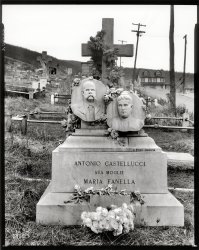
- Work From Home: 1941
- ... knew.
[Not to mention Dorothea Lange, Gordon Parks, Walker Evans et al. - Dave]
The Coming War Years I love these snapshots in ... Posted by Dave - 12/23/2018 - 12:25pm -
![Work From Home: 1941 January 1941. "Scene in west Aliquippa, Pennsylvania. Stacks of the Jones and Laughlin Steel Corporation in background." Medium format negative by Jack Delano for the Farm Security Administration. View full size.
I don't know a thing ... about the Farm Security Administration. It's hard to imagine a government agency with such a mundane handle could produce an artist like Jack Delano. I'll bet they never knew.
[Not to mention Dorothea Lange, Gordon Parks, Walker Evans et al. - Dave]
The Coming War YearsI love these snapshots in time. A year after this photo was taken, the steel mills of Pennsylvania would soon be working overtime for the war effort.
(The Gallery, Factories, Jack Delano)](https://www.shorpy.com/files/images/SHORPY-8c04647a.thumbnail.jpg)























